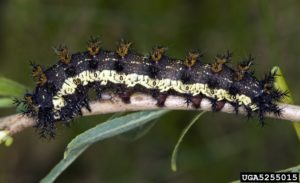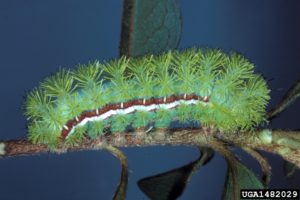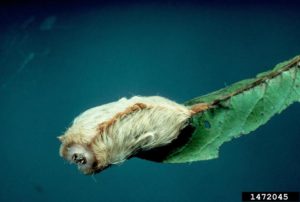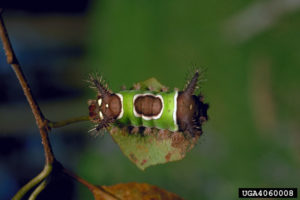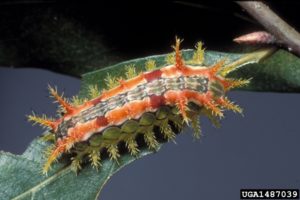General Information
Stinging caterpillars are very diverse in their growth and development. Some may live in clusters and disperse before pupating or they can be solitary. Some stinging caterpillars are host plant specific and only feed on one plant, such as the buck moth caterpillar that feeds only on oaks. But other caterpillar species can develop on a wide range of hosts. Some species have a single generation each year while others have multiple generations. Species identification is important for making the best management decisions.
Stinging caterpillars have a series of hollow, glass-like hairs or spines on the body that contain amino acid venom. When touched the spines break off in the skin and the venom inside runs down the spine into the open wound created by the spine. This is what produces the burning, stinging sensation, reddening and swelling. Some people are very sensitive to the venom and may require medical attention.
Effects of the rash produced by these caterpillars can be reduced through the application of over-the-counter insect bite and sting products. Treatment of sting areas with ice packs or ammonia may give some relief from pain. However, for severe reactions, victims should promptly seek medical attention.
There are many caterpillars with hairs or spines on their bodies, but not all of them contain venom. Some species mimic the stinging caterpillars in appearance so they will be left alone. Identification is important because touching the wrong caterpillar can be painful.
Identification
| Species | Description | Where to Look |
|
Buck Moth Caterpillar Hemileuca maia
|
Adult buck moths have a wingspan that ranges from 2-3 inches. Buck moth caterpillars live gregariously in their early instars they are black and white caterpillars use branching spines to fend off predators. Eggs are laid in clusters on twigs of host trees during the fall. | Buck moth infestations are usually small and localized. Post oak seems to be a favored host. The caterpillars possess poisonous spines capable of causing painful skin irritation. |
|
Io Moth Caterpillar Automeris io
|
Adult moth have white filled, black and blue eyespots and hindwing are distinctive. Overall color varies from reddish to yellowish. Males are yellower, females redder. Caterpillars gregarious in early instars, starting out orange then maturing to pale blue-green with clusters of spines and a red line along each side with white underneath | Fields and forests from southern Canada all the way to Florida and Texas. Because stinging caterpillars are an occasional invader, the best option for this group of pests is to train grounds crew personnel and custodial personnel to keep eye on trees and shrubs for possible caterpillar development. Some of the caterpillars occur on a wide variety of trees, shrubs and other plants, including corn. Common tree hosts are apple, basswood, cherry, dogwood, elm, maple, oak and plum. |
| Puss Caterpillar Megalopyge opercularis
|
The puss caterpillar (the adult is called southern flannel moth) is one of the most “dangerous” stinging caterpillar. This caterpillar is thickly covered with fine, long, tan, grayish to brown hairs, among which are hidden venomous setae. Hairs peak roof-like over the back and taper rearward to form a “tail”. Hairs along the “ridge” of the back occur in small tufts; on each side are small patches of white. The full-grown larva is about 1 inch long, but with its hairy coat, appears to be much larger. The bodies of late instar puss caterpillars are normally completely hidden from sight by the thick coating of hair (setae). However, the head and prothorax may be exposed when the larvae are moving about or occasionally when feeding. | Puss caterpillars, one of the most toxic, feed on foliage of a variety of broadleaf trees and shrubs. Some common tree hosts are apple, elm, hackberry, maple, oak, pecan and sycamore. Two larval broods likely occur each season in the south, one in spring and early summer and one in late summer and fall. It is the caterpillars of the second brood that are most often encountered. |
| Saddleback caterpillar Acharia stimulea
|
Caterpillars are the immature, larval form of butterflies and moths. Acharia stimulea adults are glossy dark brown in color with black shading. Dense scales are present on the body and wings, giving it a furry appearance. Wing span ranges from 26–43 mm (1.0–1.7 in), with females typically larger in size than males. A single white dot is present near the forewing base. Near the forewing apex, one to three additional white dots are present. The hind wings will be a paler brown than the forewings. | It is native to a large range in the eastern United States and able to feed on a wide array of host plant species. This species can survive well in northern temperate areas and warmer southern climates. The saddleback caterpillar is encountered most frequently as a medically significant pest, and has minor effects in landscaping and agriculture. Caterpillars occur on a wide variety of trees, shrubs and other plants, including corn. Common tree hosts are apple, basswood, cherry, dogwood, elm, maple, oak and plum. |
| Spiny Oak Slug Caterpillar Euclea delphinii
|
The full-grown larva is about 3/4 inch long. Basic color is yellow-green but color, especially of the pattern on the back, may vary. There are three pairs of large horn-like spines with black-tipped bristles at the front and two pairs at the rear. Clumps of smaller spines occur in rows along the back and sides. There are four dense clumps of small dark spines at the rear end; these are important characteristics for identifying the species. | The caterpillar feeds on foliage of several woody plants including beech, cherry, maple, oak, redbud, sycamore, and willow. It is usually found in late summer and fall. Movement is slow, gliding, slug-like. Most species tend to be solitary feeders, and seldom occur in sufficient abundance to cause serious loss of tree foliage. |
Suggested Thresholds
One stinging caterpillar report on neighboring trees, shrubs or other plant material in close proximity of the school campus will justify monitoring for activity.
Monitoring and Inspection
Because stinging caterpillars are an occasional invader, the best option for this group of pests is to train grounds crew personnel and custodial personnel to keep eye on trees and shrubs for possible caterpillar development. Some of the caterpillars occur on a wide variety of trees, shrubs and other plants, including corn. Common tree hosts are apple, basswood, cherry, dogwood, elm, maple, oak and plum.
Puss caterpillars, one of the most toxic, feed on foliage of a variety of broadleaf trees and shrubs. Some common tree hosts are apple, elm, hackberry, maple, oak, pecan and sycamore.
Nonchemical Control Measures
Sanitation/Cultural Control Measures
- Avoid handling any hairy caterpillars or material with which they have been in contact.
- Teachers, parents and staff should be educated about not handling these pests.
Physical/Mechanical Control Measures
- Knock caterpillars off the plant and crush where possible. Relocate or remove plants that are known hosts, if possible.
- Vacuum caterpillars off plants and dump the vacuum container in a bucket of soapy water.
- Suitable protective clothing, including eye-wear and gloves should always be worn when handling these insects.
- Remember, dead caterpillars can still cause painful stings.
- Most caterpillar infestations are usually short lived and should be left undisturbed, unless they are causing a problem. However, these infested areas should be noted and avoided.
- Most infestations will die out either through predation or when all food sources are removed or exhausted. Only plant tree and shrub species that do not attract stinging caterpillars.
- Where stinging caterpillars present hazards to people, such as around residences or schools, infested shrubs and trees may be vacuumed, sprayed or dusted to reduce or eliminate the caterpillars.
Chemical Control Measures
Where stinging caterpillars are numerous or present hazards to people, such as around residences, recreation areas or schools, infested shrubs and trees may be sprayed to eliminate or reduce the caterpillars.
Lightly dust the leaves and infested areas with products containing Bacillus thuringiensis var. kurstaki and/or Safer’s insecticidal soap if caterpillars are small. Contact insecticides containing acephate, carbaryl, pyrethroids (permethrin, bifenthrin, cypermethrin, lambda-cyhalothrin) or others possibly mixed with an adjuvant or liquid soap can be used on populations that need quick knockdown. Always read and follow the label. The label is the law. Pesticides must be used in accordance with federal, state and local regulations. Applicators must have proper credentialing to apply pesticides and should always wear personal protective equipment (PPE) as required by the pesticide label during applications. All labels and Safety Data Sheets (SDS) for the pesticide products authorized for use in the IPM program should be maintained on file.
Evaluation Methods
Regularly monitor plants where stinging caterpillars have been located. If stinging caterpillars are discovered, decide which combination of the above tactics to use to implement your management plan.
